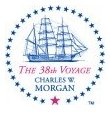
38Talk:
A Forum for Discussions among Voyagers and Others related to the 38th Voyage of the Charles W. Morgan
Re: John Manjiro's translation of Bowditch
From: Frank Reed
Date: 2014 Oct 7, 10:20 -0700
From: Frank Reed
Date: 2014 Oct 7, 10:20 -0700
Ger Tysk, you wrote:
"A complete copy of the translation is at the John Mung Museum in his hometown of Nakanohama - it's obviously not an original, and the sign that accompanies it makes it very clear that it's only a copy, not the original."
Thank you. The explanation for the display of the unfortunately generic table of logarithms then would probably be something quite mundane... a curator opened the copy to a random page that looked impressive and did not realize that it was information known in Japan long before Manjiro. As I mentioned to you last week in Mystic, the final issue that convinced me is the page layout. The version in your photo from the John Mung Museum is laid out almost exactly like the corresponding page in a contemporary copy of Bowditch (that table did not change for eighty years).
You added:
"You mention that Manjiro's "level of education was very low" but that's not the case. He might have been an illiterate fisherman when he left Japan, but he eventually became a lecturing professor at Todai University in Tokyo until he died"
"You mention that Manjiro's "level of education was very low" but that's not the case. He might have been an illiterate fisherman when he left Japan, but he eventually became a lecturing professor at Todai University in Tokyo until he died"
Well, it's a problem of self-education when it comes to Bowditch. When he arrived back in Japan, he was still illiterate in the Japanese written language, and his knowledge of celestial navigation would have been very basic and probably quite practical. Only about 5% of Bowditch was actually essential to navigation. Navigation is far easier than the size of that book would suggest! But thinking more on it, that process of translation, even if it was a quite literal translation and, in a sense, uninformed, would have been a good way for Manjiro to "bootstrap" himself from the basic level of education required aboard a whaleship to the level required to translate Bowditch competently. Learn as you go. And, as we discussed, in that period, after he was made a samurai, he probably had a huge staff working on the project with him. He could learn Japanese and learn math at the same time.
You wrote:
"The Japanese also at that time had no navy and no concept of navigation out of view of the shore. Because of their policy of isolation, they never had any need to use celestial navigation, but sailed by following the coastline. All of their trade ships were shallow water ships only, and although they had knowledge of navigation from the Dutch, they had no way to apply it, as Japanese were not allowed to sail on Dutch ships."
There is a story from a Dutch vessel c.1810 (which unfortunately I cannot locate) of a Japanese "student of navigation" insisting that he wanted to learn how to determine longitude (since latitude is relatively trivial). As you say, there was almost no need for celestial navigation on sailing vessels. But then there is the wider question of mathematical calculation and astronomical position-finding. A surveyor working on land could benefit as much from the science of celestial navigation as an ocean-going navigator. There were small numbers of mathematical experts in Japan, apparently, who took some interest in these methods and knew about logarithms and so on. They must have been instrumental in making the translation of Bowditch possible.
You concluded:
"As a Japanese person who actually knew how to sail and had done it professionally, Manjiro introduced the practical concept of navigation, taught celestial navigation to the Japanese using his translation of Bowditch, and was instrumental in building the Japanese into a naval power."
Yes. Agreed.
My interest in this topic hinges on the question of the significance of Bowditch's Navigator. In legend, even today, "Bowditch" (the book, not the man) is known as the "bible" of navigation. And it does look rather biblical. But it's a poor textbook, always has been. And there were many other navigation manuals in the 19th century that navigators on whaling ships would have used. For example, Norie's Navigator was very popular in the non-US English-speaking world. One of the best measures of the influence of any book is translation. Books that get translated contain unique content. The wide translation of Moby-Dick is an excellent measure of its influence. The only example of a translation of Bowditch that has ever been attested is Manjiro's translation into Japanese. The significance of that translation bears directly on the significance of Bowditch.
After a decade of hunting, and being told at every turn that all copies had been destroyed, it's wonderful to learn that Manjiro's Bowditch does still exist. I'll have to to dig further and see if I can get my hands on some pages that are more unique to the actual navigation content.
Thanks again!
Frank Reed
ReedNavigation.com
Conanicut Island USA
Conanicut Island USA








